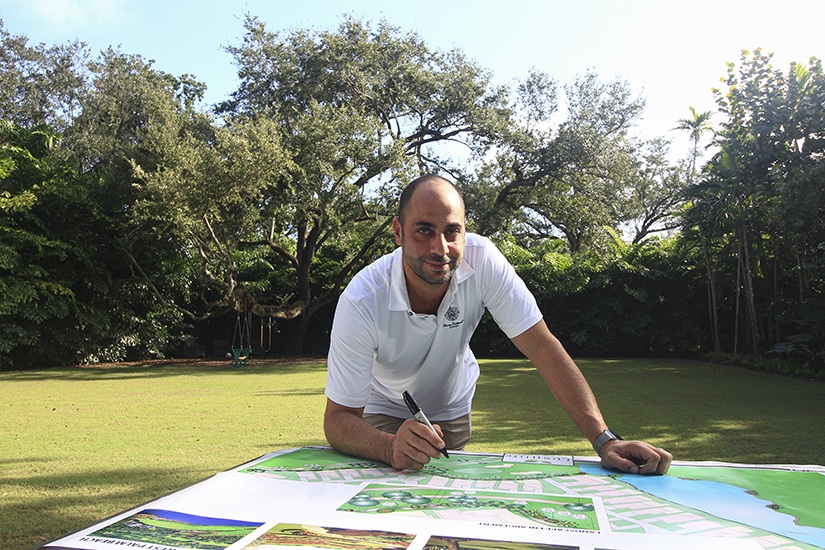|
Getting your Trinity Audio player ready...
|
In the 11 years since Oren Kattan founded LUSHlife, a professional landscaping company based in south Florida, the company has cultivated some of the most prestigious names in luxury and hospitality to create living works of art. While LUSHlife built its early reputation on residential properties, as the years progressed, the focus has been more on high-end projects, doing work for Armani, the SLS Lux, and the One Thousand Museum luxury condo residences in Miami.
The progress the company has made is no accident; Kattan explains that he stands behind his work, no matter the cost. “Taking responsibility for your work is the number one aspect of why our customers love us,” the founder and CEO says. “If there’s a problem, we will always come faster than when it’s pay day. That’s really when you show your worth: when there are problems, not when people are writing checks.”

Kattan was raised in Miami, after graduating from Florida International University he entered the world of real estate and development. During that time, one of his early mentors emphasized the importance that landscaping plays in any project. “It’s able to create a first impression before anyone even enters a building,” Kattan says. Using this as a motto, LUSHlife’s portfolio shows an exacting attention to detail, delivering cutting-edge greenery that is striking yet effortless.
That effortless feeling is carried through even when faced with south Florida’s biggest threat: hurricanes. Hurricane Irma’s 2017 tour of the Southeastern United States—the third-strongest Atlantic hurricane ever recorded at landfall—was enough to seriously disrupt two of LUSHlife’s ongoing projects.
The Paraiso District in Miami already had enough challenges: four separate high-rise buildings had been plotted by two different landscape architects. “We had two teams to deal with, so there was an interesting dynamic of just trying to work with all the different personalities,” Kattan remembers. “And then there was the storm.”

Hurricane Irma sent saltwater over barriers, destroying already-completed landscaping. Hundreds of thousands of dollars of work were lost. One of the tower cranes was left hanging off the building and neighbors had to be evacuated. But despite these setbacks, LUSHlife remained on schedule. “Always the last to finish last on a project, our product cannot be just pressure-washed and painted. Because we are dealing with a living organism, our product extends to the future of the building and its aesthetics. It is very challenging to not have our work ruined either by other trades, Mother Nature, or human error.”
Another project of theirs, the Armani building, also faced issues due to the hurricane. “The storm really limited our inventory at the time,” Kattan says. “I think up until three weeks before opening, we were still only working off blueprints. This was a job that after years of planning, we had to execute on in such a short period of time, but I think we were very successful.”
Kattan says his team often finds itself having to think on its feet. Their SLS Lux project featured one of the largest green walls in south Florida—until the company outdid itself on the Armani project. The massive 27-foot-tall structure presented its own challenges. “That was the job where we figured out that no lifts with extending platforms go past 20 feet for work height,” Kattan says, laughing. “We had to build scaffolding over the planters and figure it out.”

Currently, LUSHlife is in the early stages of a project for the Waldorf Astoria. “I think it’s going to be a phenomenal project,” Kattan says. “There are world-class architects working on it and I know it’s going to be another great addition to our portfolio.”
The relationships the company has been able to develop over time have played a big part in building its portfolio. “I think we have a great reputation with our customers because when it comes down to it, we’re able to get architects on the phone and get a decision to be made so that the project is able to be successful,” Kattan says. Those partnerships include PMG, Related Group, and other large players in the south Florida development game.
For Kattan himself, he’s found comfort in accepting the reality of having to be the last team on the job before an opening. That means color-coordinated overnight greenery implementations and doing whatever needs to be done to meet a deadline. When there are construction delays, it often falls to the landscaping team to make up for lost time.
“In being the last on the job, I’ve learned that whatever you think you’re going to have on your schedule, you should expect to have about half of that time,” Kattan says. “And you just have to make yourself available. Change is always coming in this industry, and you have to be ready for it.”


